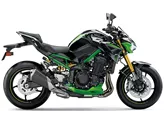Kawasaki Z 800 2013 vs. Kawasaki Z1000 2014

Kawasaki Z 800 2013

Kawasaki Z1000 2014
Vue d’ensemble - Kawasaki Z 800 2013 vs Kawasaki Z1000 2014
The Kawasaki Z 800 2013 and the Kawasaki Z1000 2014 are both naked bikes with similar engine types, inline four-cylinder engines. However, there are several differences between the two models.
In terms of engine power, the Z1000 2014 has a significant advantage with 142 HP compared to the Z800 2013's 113 HP. This translates to a more powerful and exhilarating ride on the Z1000. The torque is also higher on the Z1000 with 111 Nm compared to the Z800's 83 Nm, providing better acceleration and overall performance.
Both bikes have liquid cooling systems to ensure optimal engine temperature. The Z800 has a displacement of 806ccm, while the Z1000 has a larger displacement of 1043ccm. This means that the Z1000 has a larger engine and potentially more power.

Kawasaki Z 800 2013
In terms of suspension, both bikes feature upside-down telescopic forks at the front. However, the Z1000 offers more adjustability with compression, preload, and rebound adjustments, allowing for a more customized riding experience. The Z800 only has rebound adjustment for the front suspension.
The chassis of the Z800 is made of steel, while the Z1000 features an aluminum frame. This makes the Z1000 lighter and potentially more agile in corners. Both bikes have a double cradle frame design, providing stability and rigidity.
Both bikes have double disc brakes at the front with four pistons. The Z1000 has the added advantage of radial technology for the front brakes, which enhances braking performance. Both models also feature petal brake discs, which help with heat dissipation and provide a sporty look.

Kawasaki Z1000 2014
In terms of dimensions and weights, the Z800 has a slightly wider rear tire at 180mm compared to the Z1000's 190mm. The Z800 also has a slightly higher seat height at 834mm, while the Z1000 has a lower seat height at 815mm. The Z1000 is slightly lighter with a kerb weight of 221kg compared to the Z800's 229kg. Both bikes have a similar wheelbase, with the Z800 at 1445mm and the Z1000 at 1435mm.
One weakness of the Z800 is its limited freedom of movement for the legs, which may be uncomfortable for taller riders. On the other hand, the Z1000's main weakness is its high purchase price compared to other bikes in its class, such as the S1000R.
In summary, the Kawasaki Z1000 2014 offers more power, better suspension adjustability, and a lighter chassis compared to the Z800 2013. However, it comes at a higher price. Both bikes have powerful brakes and attractive designs, but the Z1000 is praised for its sophisticated design and pleasant handling.
Caractéristiques techniques Kawasaki Z 800 2013 par rapport à Kawasaki Z1000 2014
Avantages et inconvénients en comparaison
Avantages et inconvénients en comparaison
Kawasaki Z 800 2013

Dans l'ensemble, la Z800 a livré une performance sensationnelle. Compte tenu du fait que rien n'a été modifié ou optimisé sur le véhicule, à l'exception du pot d'échappement Remus, le résultat final est superbe.
Kawasaki Z1000 2014

La Kawasaki Z1000 (2014) est une déclaration contre la tendance électronique de son époque - et c'est précisément ce qui la rend particulière aujourd'hui. Son quatre cylindres au caractère bien trempé, sa mécanique directe et sa focalisation sans compromis sur l'essentiel répondent aux attentes d'une époque où de nombreuses motos sont devenues des ordinateurs roulants. Oui, elle renonce aux systèmes avancés d'aide au pilote et à une protection parfaite contre le vent. Mais elle offre en contrepartie une authentique expérience de conduite de nakedbike, associée à la fiabilité japonaise et à des coûts d'entretien raisonnables. La Z1000 n'est pas une machine pour les drogués de la fiche technique ou les fans d'électronique - c'est une moto pour ceux qui veulent encore décider eux-mêmes de leur conduite. Une moto honnête avec du caractère, qui continue à enthousiasmer même après des années et qui fait plus que remplir son rôle d'antithèse émotionnelle de la modernité Digital.
Comparaison des prix Prix moyen du marché Kawasaki Z 800 vs Kawasaki Z1000
There are a few key differences between a Kawasaki Z 800 2013 and a Kawasaki Z1000 2014. In terms of price, the actual average price of a Kawasaki Z1000 2014 is about 38% higher. Compared to Kawasaki Z1000 2014 there are less Kawasaki Z 800 2013 bikes available on the 1000PS.de Marketplace, specifically 7 compared to 12. It takes less time to sell a Kawasaki Z 800 with 56 days compared to 75 days for a Kawasaki Z1000. Since model year 2013 1000PS.de editors have written 11 reviews for the Kawasaki Z 800 and 41 reviews for the Kawasaki Z1000 since model year 2005. The first review for the Kawasaki Z 800 was published on 9/6/2012 and now has more than 8,100 views. This compares to more than 5,800 views for the first review on Kawasaki Z1000 published on 9/2/2002.


















